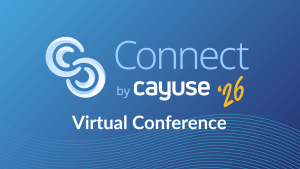Blog
The What, the Who, and the How of a Successful Implementation
At the 2024 Connect by Cayuse Virtual Conference, Bobbie Bowling, Assistant Vice President for Sponsored Programs and Integration at Central State University, and Thomas Keller, Senior Professional Services Consultant with Cayuse, presented a session on successfully implementing research administration software. With years of experience in research administration, Bobbie shared valuable insights into navigating the implementation process, involving stakeholders, and overcoming challenges.
This blog captures the key takeaways from their discussion, including what to expect, who to involve, and how to ensure success.
What to Expect During Implementation
Before implementing Cayuse, Central State University faced the challenge of modernizing its research administration processes. As Ohio’s only public historically Black college and university (HBCU) and a land-grant institution since 2014, Central State experienced rapid growth in external awards, nearly doubling its funding by FY22. Adopting new software was deemed necessary to sustain this growth and manage limited resources efficiently.
Bobbie approached the implementation with mixed feelings. While excited about the benefits Cayuse could bring, she was also apprehensive about the complexity of managing multiple systems, including Human Ethics, Sponsored Projects, Proposals S2S, and Outside Interests. Having experienced previous software implementations, she anticipated challenges in balancing day-to-day responsibilities with necessary implementation work, aligning stakeholder expectations, and ensuring team buy-in.
Fortunately, rigorous preparation helped to ensure a smoother implementation process than Bobbie expected. The discovery phase, a foundational step in Cayuse’s implementation process, proved invaluable; it helped Central State assess existing processes, identify inefficiencies, and prioritize updates. Taking this time to plan ahead allowed for open, intentional conversations between the institution and Cayuse, fostering a shared understanding of Central State’s unique needs and how the new software could be set up to meet them without cumbersome adjustments down the road.
Who to Involve in the Implementation Process
One of the most critical factors in a successful implementation is involving the right stakeholders. Bobbie emphasized the importance of a carefully constructed team that includes both seasoned staff with institutional knowledge and newer team members who bring fresh perspectives. This blend ensures a holistic approach to addressing challenges and developing solutions.
In particular, the IT department’s participation was indispensable. While they may not have been directly involved in functional operations, their understanding of the technical infrastructure, including ERP systems and databases, was crucial for seamless data migration and system integrations.
Additionally, Bobbie stressed the need for champions and allies within the institution—individuals who can advocate for the implementation, keep teams motivated, and align the project with broader strategic goals. Regular communication with leadership, including updates tied to institutional efficiency goals, ensured the project remained a priority.
Most importantly, Bobbie highlighted the value of engaging faculty and staff early in the implementation process. Their input shaped the design and usability of the system, fostering greater buy-in and smoother adoption.
How to Ensure a Successful Implementation
Central State’s implementation journey underscored several lessons for ensuring success. First, clear planning and regular check-ins were critical. Beyond the weekly meetings with Cayuse consultants, the team held internal sessions to discuss decisions and progress. These additional meetings allowed stakeholders to resolve issues collaboratively and stay aligned.
Balancing responsibilities was another important challenge to manage. Implementation tasks often became “other duties as assigned” for many team members. However, Bobbie maintained focus by reminding her team of the larger goal: creating efficiencies that would benefit faculty, staff, and students in the long term.
A strategic rollout of the new Cayuse systems also contributed to Central State’s success. The implementation team started with Outside Interests to meet reaccreditation deadlines before moving on to more complex systems like Human Ethics and Sponsored Projects. This phased approach gave teams time to adjust while ensuring high-priority needs were addressed first. Comprehensive training materials, including step-by-step guides and recorded tutorials, supported users throughout the rollout.
Finally, flexibility and adaptability proved essential when unforeseen challenges arose. For example, Central State faced setbacks related to general ledger integration, requiring creative workarounds and close collaboration with IT to resolve. Bobbie encourages other institutions to embrace adaptability and maintain open communication to navigate such hurdles effectively.
Final Takeaways
For institutions considering a Cayuse implementation, the key to success lies in preparation, collaboration, and adaptability. Engaging stakeholders early, fostering strong IT partnerships, and aligning the project with institutional goals are all important steps to ensure a successful implementation. The discovery phase, detailed resource planning, and expert guidance from Cayuse consultants also provided the necessary roadmap to keep schedules and expectations aligned.
As Bobbie reflected, successful implementation is not just about adopting new software; it’s about creating lasting efficiencies, improving transparency, and empowering teams to manage growing demands in research administration. By approaching the process with a clear vision and a collaborative mindset, institutions can achieve transformative results and set the stage for continued success.
Ready to learn more about how Cayuse helps facilitate a better implementation process for research teams? Click here for an in-depth overview of our customer-first implementation strategy.

